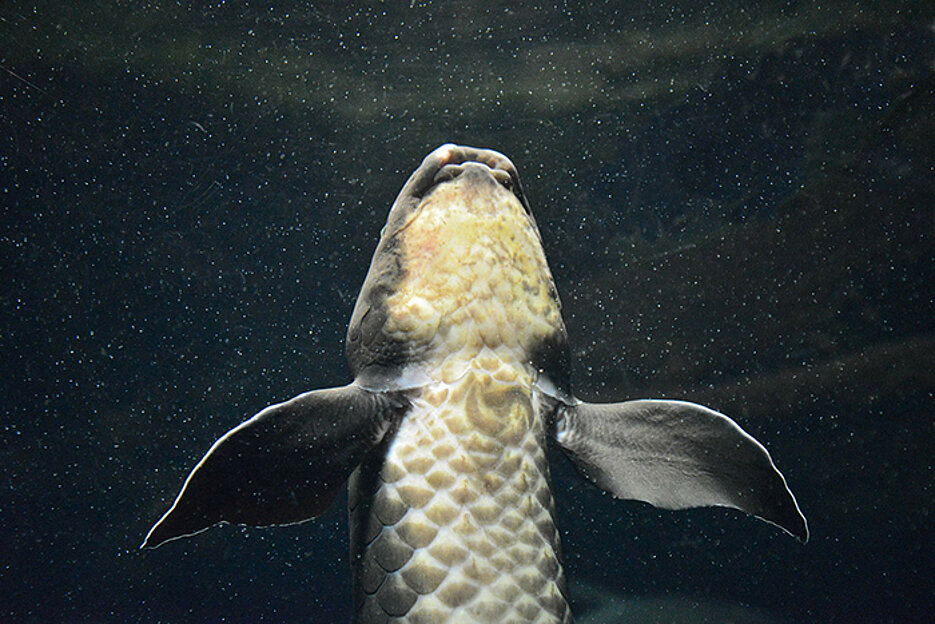The World’s Largest Animal Genome
01/19/2021The Australian lungfish replaces the Mexican axolotl as holding the record for the "largest genome in the animal kingdom". Its genome shows the evolutionary innovations that made living on land possible.

380 million years ago, the first fish began to conquer land. The Australian lungfish – an endangered air-breathing species – is one of the few living relatives of these first "land fish".
An international research team has now used the latest DNA sequencing technologies to decode the huge genome of this fish species for the first time. The analysis has been published in the journal Nature. It gives new insights into the evolutionary innovations that enabled fish to live on land.
The study was a team effort of researchers from Hamburg, Constance, Vienna, Lyon and Würzburg. Senior Professor Manfred Schartl from the Biocentre of Julius-Maximilians-Universität (JMU) Würzburg in Bavaria, Germany, an expert in the biology and evolution of fish, was an important contributor to the study as was his postdoc Kang Du and Susanne Kneitz, a bioinformatician from the JMU Chair of Biochemistry and Cell Biology.
Genome is 14 times larger than that of humans
According to the study, the lungfish genome is the largest animal genome ever sequenced. Boasting 43 billion base pairs, it is 14 times larger than the human genome, exceeding the genome of the axolotl, the previous record holder in the animal kingdom, by an impressive 30 percent.
So why is the genome so large? Astonishingly, the lungfish does not have many more genes than other vertebrates. But it does have more mobile genetic elements, so-called transposable elements. "These elements can be consider as a kind of computer virus. They multiply on their own but don't have a function. As a scientist you wonder why the 'genetic hard drive' of the lungfish has not crashed long ago given the high number of transposable elements," says Manfred Schartl.
Fins similar to human limbs
The Australian lung fish (Neoceratodus forsteri) lives in slow flowing rivers and bodies of standing water. Due to its newt-like physique, it was incorrectly assumed to be part of the amphibians in the 19th century. Today we know that as a lungfish it belongs to an archaic group of aquatic creatures from which all terrestrial vertebrates developed.
The "fleshy" fins of the lungfish possess an anatomical bone arrangement which looks already similar to that of human limbs. This allows the Australian lungfish to move like salamanders in water and on land. Moreover, they have lungs which allow them to breathe air above water so as not to drown. And they are capable of detecting airborne smells.
Closer to amphibians than to fish
The genome analysis reveals striking similarities between the Australian lungfish and terrestrial vertebrates. For example, the number and the spatial and temporal expression patterns of genes that are associated with the development of lungs, jointed limbs and with the detection of airborne smells are much more similar to amphibians and other land vertebrates than their fish relatives.
So far, scientists have debated controversially whether lungfish or the equally archaic coelacanths are more closely related to terrestrial vertebrates The study in Nature now shows that the lungfish are genetically closer to land animals and humans: 420 million ago, they split off from the coelacanths and formed a lineage leading to land animals.
Sponsors
Since 2018, the German Research Foundation (DFG) has funded the sequencing of the lungfish genome by JMU Professor Manfred Schartl, Professor Torsten Burmester (University of Hamburg) and Professor Axel Meyer (University of Constance) with more than EUR 500,000.
Publication
Axel Meyer, Siegfried Schloissnig, Paolo Franchini, Kang Du, Joost Woltering, Iker Irisarri, Wai Yee Wong, Sergej Nowoshilow, Susanne Kneitz, Akane Kawaguchi, Andrej Fabrizius, Peiwen Xiong, Corentin Dechaud, Herman Spaink, Jean-Nicolas Volff, Oleg Simakov, Thorsten Burmester, Elly Tanaka, Manfred Schartl: “Giant Lungfish genome elucidates the conquest of land by vertebrates”. Nature, 18 January 2021. DOI: 10.1038/s41586-021-03198-8
Contact
Prof. Dr. Manfred Schartl, T +49 931 31-84149, phch1@biozentrum.uni-wuerzburg.de






